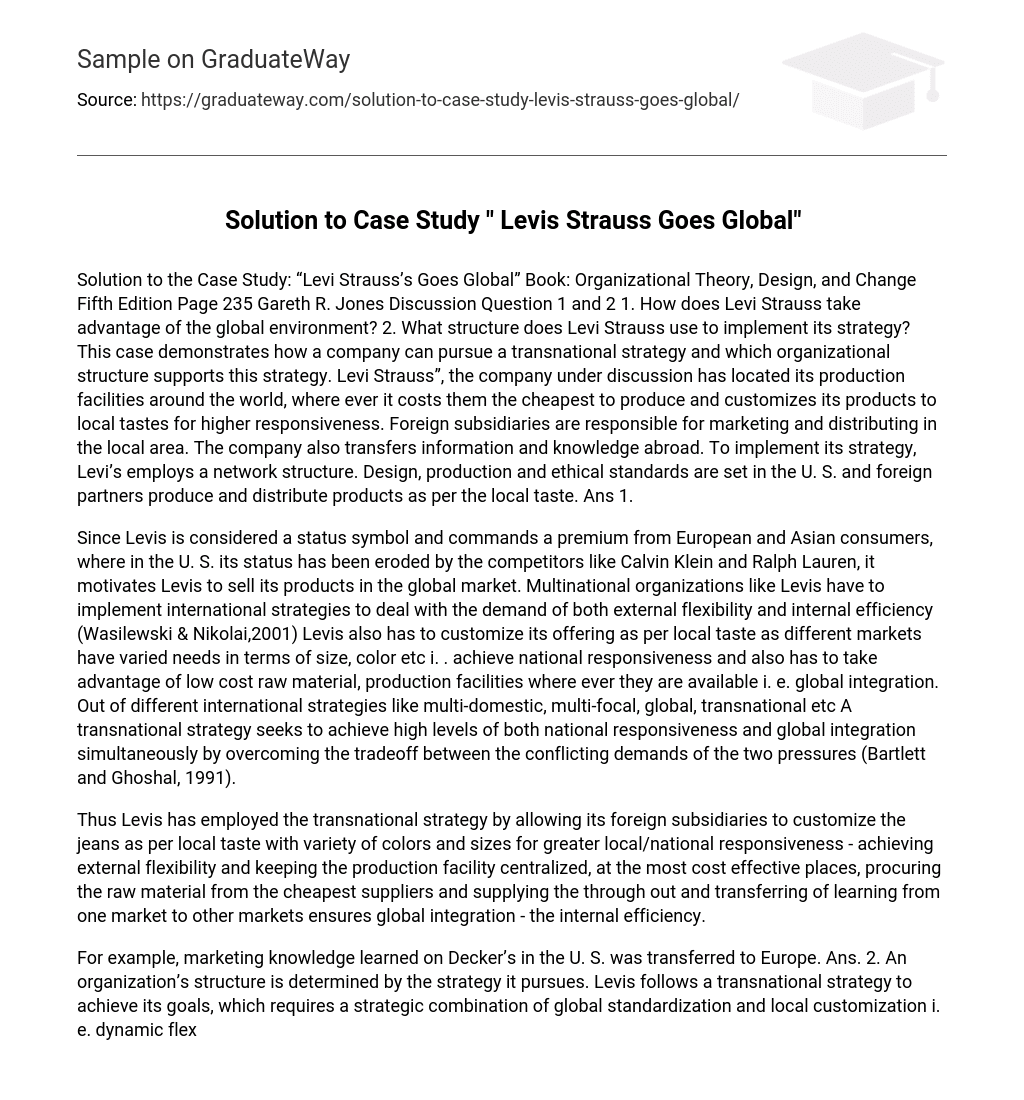How does Levi Strauss take advantage of the global environment? What structure does Levi Strauss use to implement its strategy?
This case demonstrates how a company can pursue a transnational strategy and which organizational structure supports this strategy. Levi Strauss”, the company under discussion has located its production facilities around the world, where ever it costs them the cheapest to produce and customizes its products to local tastes for higher responsiveness. Foreign subsidiaries are responsible for marketing and distributing in the local area. The company also transfers information and knowledge abroad. To implement its strategy, Levi’s employs a network structure. Design, production and ethical standards are set in the U. S. and foreign partners produce and distribute products as per the local taste.
Since Levis is considered a status symbol and commands a premium from European and Asian consumers, where in the U. S. its status has been eroded by the competitors like Calvin Klein and Ralph Lauren, it motivates Levis to sell its products in the global market. Multinational organizations like Levis have to implement international strategies to deal with the demand of both external flexibility and internal efficiency (Wasilewski & Nikolai,2001)
Levis also has to customize its offering as per local taste as different markets have varied needs in terms of size, color etc i. . achieve national responsiveness and also has to take advantage of low cost raw material, production facilities where ever they are available i. e. global integration. Out of different international strategies like multi-domestic, multi-focal, global, transnational etc A transnational strategy seeks to achieve high levels of both national responsiveness and global integration simultaneously by overcoming the tradeoff between the conflicting demands of the two pressures (Bartlett and Ghoshal, 1991).
Thus Levis has employed the transnational strategy by allowing its foreign subsidiaries to customize the jeans as per local taste with variety of colors and sizes for greater local/national responsiveness – achieving external flexibility and keeping the production facility centralized, at the most cost effective places, procuring the raw material from the cheapest suppliers and supplying the through out and transferring of learning from one market to other markets ensures global integration – the internal efficiency. For example, marketing knowledge learned on Decker’s in the U. S. was transferred to Europe.
An organization’s structure is determined by the strategy it pursues. Levis follows a transnational strategy to achieve its goals, which requires a strategic combination of global standardization and local customization i. e. dynamic flexibility. The centralization/decentralization required by a firm depends on demand for global integration and local responsiveness.
In transnational strategy the firm strives for a very high degree of both global integration and local customization. To follow this strategy Levis uses Network Structure. In Network Structure the core decisions (competencies) are centralized at the main organization and other decisions are outsourced to the partner organizations( subsidiaries), so that the organization can focus on its core competencies and generate economies of scale while subsidiaries can use their discretion for customizing the products, price, promotion etc to better respond to the local needs.
Levis’ core competency lies in designing and thus it keeps designing centralized in the United States and production, ethical, corporate governance decisions are also made centrally in the United States while the series of alliances it has made with foreign companies produces and distributes the products in different countries. The partner companies have to follow the standards set by Levis, failing which their alliance may be terminated. Thus Levis implements its transnational strategy with this blend of global integration and local adaptation.
Bibliography
- Transnational Marketing Strategies : Performance and Limitations – Article by Wasilewski & Nikolai, Global competitiveness,2001
- Organizational Behavior – Book by Stephen P. Robbins, Timothy A. Judge,2007





